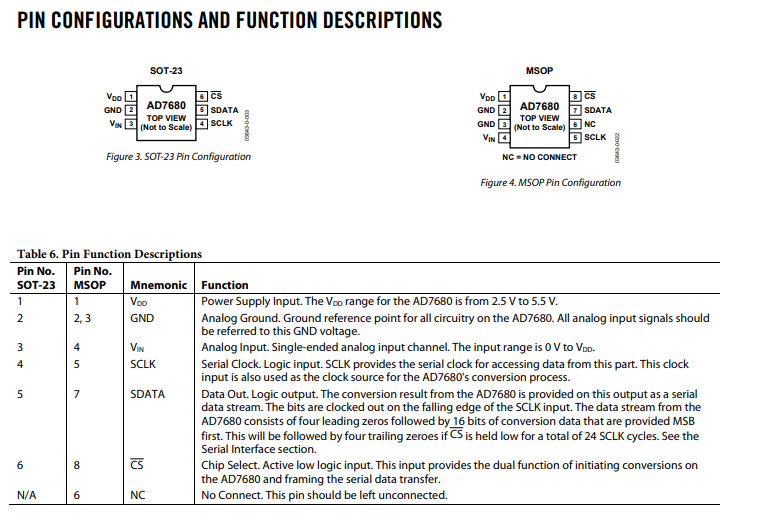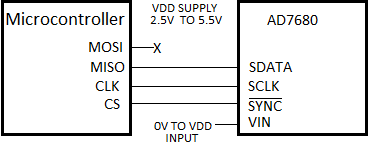Difference between revisions of "Component: ADC (AD7680) (Analog Input)"
From Flowcode Help
Jump to navigationJump to search| (18 intermediate revisions by 2 users not shown) | |||
| Line 1: | Line 1: | ||
| − | + | {| style="width:50%" | |
| − | |||
| − | {| | ||
|- | |- | ||
| − | | width="20%" style="color: gray;" | Author | + | | width="20%" style="color:gray;" | Author |
| Matrix TSL | | Matrix TSL | ||
|- | |- | ||
| − | | width="20%" style="color: gray;" | Version | + | | width="20%" style="color:gray;" | Version |
| − | | 1.0 | + | | 1.0 |
|- | |- | ||
| − | | width="20%" style="color: gray;" | Category | + | | width="20%" style="color:gray;" | Category |
| Analog Input | | Analog Input | ||
|} | |} | ||
| + | ==ADC (AD7680) component== | ||
| + | 16-bit external ADC connected to the microcontroller using SPI. | ||
| + | |||
| + | ==Component Source Code== | ||
| + | |||
| + | Please click here to download the component source project: [https://www.flowcode.co.uk/wiki/componentsource/FC_Comp_Source_ExternalADC_AD7680.fcfx FC_Comp_Source_ExternalADC_AD7680.fcfx] | ||
| − | + | Please click here to view the component source code (Beta): [https://www.flowcode.co.uk/FlowchartView/?wfile=componentsource/FC_Comp_Source_ExternalADC_AD7680.fcfx FC_Comp_Source_ExternalADC_AD7680.fcfx] | |
| − | |||
==Detailed description== | ==Detailed description== | ||
| − | |||
| − | |||
| − | |||
| − | |||
| − | |||
| − | |||
| − | |||
| − | |||
| − | |||
| − | |||
| − | |||
| − | |||
| − | |||
| − | |||
| − | |||
| − | |||
| − | |||
| − | |||
| − | |||
| − | |||
| − | |||
| − | |||
| − | |||
| − | |||
| − | |||
| − | |||
| − | |||
| − | + | ||
| + | ===Overview=== | ||
| + | The AD7680 is a 2.5V to 5.5V SPI compatible, successive | ||
| + | approximation analogue to digital converter (ADC). | ||
| + | |||
| + | The reference for the AD7680 is taken internally from VDD | ||
| + | |||
| + | |||
| + | Pin reference from the datasheet: | ||
| + | |||
| + | [[File:AD7680 Pin Reference.png]] | ||
| + | |||
| + | ==Examples== | ||
| + | |||
| + | |||
| + | |||
| + | |||
| + | |||
| + | |||
| + | |||
| + | |||
| + | |||
| + | |||
| + | |||
| + | |||
| − | |||
| − | |||
| − | |||
| − | |||
| − | |||
| − | |||
| − | |||
| − | |||
| − | |||
| − | |||
| − | |||
| − | |||
| − | |||
| − | |||
| − | This | + | This example reads the voltage on the AD7680 Vin and converts the ADC results into a voltage. |
| + | For the result to be correct, you must change the Voltage variable to match the supply voltage. | ||
| − | + | {{Fcfile|AD7680 Demo.fcfx|AD7680 Demo}} | |
| + | ==Circuit Diagram== | ||
| + | [[File:AD7680 Circuit Diagram.png]] | ||
| − | |||
| − | |||
| − | |||
| − | |||
| − | |||
| − | |||
| − | |||
| − | |||
| − | |||
| − | |||
| − | + | ==Macro reference== | |
| − | + | ===Initialise=== | |
| + | {| class="wikitable" style="width:60%; background-color:#FFFFFF;" | ||
| + | |- | ||
| + | | width="10%" align="center" style="background-color:#D8C9D8;" align="center" | [[File:Fc9-comp-macro.png]] | ||
| + | | width="90%" style="background-color:#D8C9D8; color:#4B008D;" | '''Initialise''' | ||
| + | |- | ||
| + | | colspan="2" | Initialise the SPI bus ready for communications, | ||
| + | |- | ||
| + | |- | ||
| + | | width="10%" align="center" style="border-top: 2px solid #000;" | [[File:Fc9-void-icon.png]] - VOID | ||
| + | | width="90%" style="border-top: 2px solid #000;" | ''Return'' | ||
| + | |} | ||
| − | |||
| − | + | ===SampleADC=== | |
| + | {| class="wikitable" style="width:60%; background-color:#FFFFFF;" | ||
| + | |- | ||
| + | | width="10%" align="center" style="background-color:#D8C9D8;" align="center" | [[File:Fc9-comp-macro.png]] | ||
| + | | width="90%" style="background-color:#D8C9D8; color:#4B008D;" | '''SampleADC''' | ||
| + | |- | ||
| + | | colspan="2" | Reads the ADC and returns the reading as an unsigned 16-bit value. Range: 0-65535 / 0=0V / 65535=VCC | ||
| + | |- | ||
| + | |- | ||
| + | | width="10%" align="center" style="border-top: 2px solid #000;" | [[File:Fc9-u16-icon.png]] - UINT | ||
| + | | width="90%" style="border-top: 2px solid #000;" | ''Return'' | ||
| + | |} | ||
| − | |||
| − | + | ==Property reference== | |
| − | '' | + | {| class="wikitable" style="width:60%; background-color:#FFFFFF;" |
| + | |- | ||
| + | | width="10%" align="center" style="background-color:#D8C9D8;" | [[File:Fc9-prop-icon.png]] | ||
| + | | width="90%" style="background-color:#D8C9D8; color:#4B008D;" | '''Properties''' | ||
| + | |- | ||
| + | |- | ||
| + | | width="10%" align="center" style="background-color:#EAE1EA;" | [[File:Fc9-conn-icon.png]] | ||
| + | | width="90%" style="background-color:#EAE1EA; color:#4B008D;" | SPI Properties | ||
| + | |- | ||
| + | |- | ||
| + | | width="10%" align="center" | [[File:Fc9-type-16-icon.png]] | ||
| + | | width="90%" | Channel | ||
| + | |- | ||
| + | | colspan="2" | SPI Channel selector | ||
| + | |- | ||
| + | | width="10%" align="center" | [[File:Fc9-type-16-icon.png]] | ||
| + | | width="90%" | Prescale | ||
| + | |- | ||
| + | | colspan="2" | Prescale option selector | ||
| + | |- | ||
| + | | width="10%" align="center" | [[File:Fc9-type-5-icon.png]] | ||
| + | | width="90%" | MOSI | ||
| + | |- | ||
| + | | colspan="2" | SPI Data Out Pin SDO - Also Known as Master Out Slave In (MOSI) when used in Master mode. | ||
| + | |- | ||
| + | | width="10%" align="center" | [[File:Fc9-type-5-icon.png]] | ||
| + | | width="90%" | MISO | ||
| + | |- | ||
| + | | colspan="2" | SPI Data In Pin SDI - Also Known as Master In Slave Out (MISO) when used in Master mode. | ||
| + | |- | ||
| + | | width="10%" align="center" | [[File:Fc9-type-5-icon.png]] | ||
| + | | width="90%" | CLK | ||
| + | |- | ||
| + | | colspan="2" | SPI Clock Pin CLK - The Clock signal is driven by the SPI master. | ||
| + | |- | ||
| + | | width="10%" align="center" | [[File:Fc9-type-5-icon.png]] | ||
| + | | width="90%" | CS / SS | ||
| + | |- | ||
| + | | colspan="2" | Chip Select / Slave Select Pin Master Mode: General purpose output pin used to select the remote SPI device. Slave Mode: Hardware chip select pin input used to select the SPI device. | ||
| + | |- | ||
| + | | width="10%" align="center" style="background-color:#EAE1EA;" | [[File:Fc9-conn-icon.png]] | ||
| + | | width="90%" style="background-color:#EAE1EA; color:#4B008D;" | Simulation | ||
| + | |- | ||
| + | |- | ||
| + | | width="10%" align="center" | [[File:Fc9-type-7-icon.png]] | ||
| + | | width="90%" | Data Recorder Trace | ||
| + | |- | ||
| + | | colspan="2" | | ||
| + | |- | ||
| + | | width="10%" align="center" | [[File:Fc9-type-7-icon.png]] | ||
| + | | width="90%" | Simulate Comms | ||
| + | |- | ||
| + | | colspan="2" | | ||
| + | |} | ||
Latest revision as of 13:10, 7 February 2023
| Author | Matrix TSL |
| Version | 1.0 |
| Category | Analog Input |
Contents
ADC (AD7680) component
16-bit external ADC connected to the microcontroller using SPI.
Component Source Code
Please click here to download the component source project: FC_Comp_Source_ExternalADC_AD7680.fcfx
Please click here to view the component source code (Beta): FC_Comp_Source_ExternalADC_AD7680.fcfx
Detailed description
Overview
The AD7680 is a 2.5V to 5.5V SPI compatible, successive approximation analogue to digital converter (ADC).
The reference for the AD7680 is taken internally from VDD
Pin reference from the datasheet:
Examples
This example reads the voltage on the AD7680 Vin and converts the ADC results into a voltage. For the result to be correct, you must change the Voltage variable to match the supply voltage.
Circuit Diagram
Macro reference
Initialise
| Initialise | |
| Initialise the SPI bus ready for communications, | |
| Return | |
SampleADC
| SampleADC | |
| Reads the ADC and returns the reading as an unsigned 16-bit value. Range: 0-65535 / 0=0V / 65535=VCC | |
| Return | |

